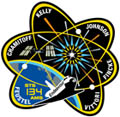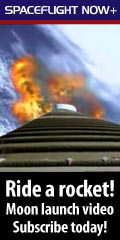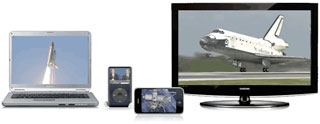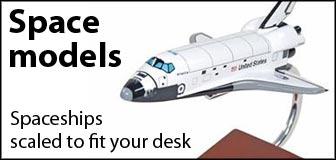 Orbiter: Endeavour Mission: STS-134 Payload: AMS Launch: May 16, 2011 Time: 8:56 a.m. EDT Site: Pad 39A, Kennedy Space Center Landing: June 1 @ approx. 2:32 a.m. EDT Site: KSC's Shuttle Landing Facility  
|
Mission Status CenterLive coverage of space shuttle Endeavour's STS-134 mission to the International Space Station. Text updates will appear automatically; there is no need to reload the page. Follow us on Twitter. TUESDAY, MAY 24, 2011
The Endeavour astronauts helped out with space station maintenance Tuesday, beginning work to service a carbon dioxide scrubber and to install a filter in a U.S. oxygen generator amid preparations for an overnight spacewalk, the third of four planned by the shuttle's crew.
Read our full story. 0440 GMT (12:40 a.m. EDT)
Endeavour pilot Greg Johnson and mission specialist Greg Chamitoff are fielding questions in live media interviews with San Francisco stations KPIX-TV and KGO-TV and KFBK Radio of Sacramento.
0410 GMT (12:10 a.m. EDT)
Outgoing space station commander Dmitry Kondratyev, Italian astronaut Paolo Nespoli and Catherine "Cady" Coleman undocked and returned to Earth Monday, pausing briefly to snap long-sought pictures of the station with a space shuttle attached before dropping out of orbit and landing in Kazakhstan to close out a 159-day voyage.
Read our landing story. 0315 GMT (11:15 p.m. EDT Mon.)
With Kondratyev, Coleman and Nespoli back on the planet safe and sound, the International Space Station continues to circle Earth with the new Expedition 28 crew of commander Andrey Borisenko, Ron Garan and Alexander Samokutyaev.
Another three-person crew -- NASA's Mike Fossum, Russian cosmonuat Sergei Volkov and Japanese astronaut Satoshi Furukawa -- will launch aboard a Soyuz from Baikonur Cosmodrome on June 7 at 4:15 p.m. EDT and reach the space station June 9 at 5:15 p.m. EDT to boost the outpost's resident team to the full size of six members. The station partners are employing "indirect crew handovers" that see the returning members land a couple of weeks prior to their replacements launching. 0306 GMT (11:06 p.m. EDT Mon.)
All three space fliers will be choppered to a Kazakh city for the traditional welcoming ceremony, then Kondratyev takes a plane back to Star City outside Moscow while Coleman and Nespoli will board a NASA aircraft for the long flight to Houston.
0256 GMT (10:56 p.m. EDT Mon.)
Paolo Nespoli has been extracted from the Soyuz and is now being seated outside in a reclining chair next to the crewmates.
This was his second trip to the International Space Station for the European Space Agency, following the STS-120 mission aboard the shuttle Discovery that delivered the Harmony connecting module in 2007. A native of Milan, Italy, Nespoli holds degrees in aerospace engineering, aeronautics and astronautics, served in the Italian army and became a master parachutist. He has been a member of Europe's astronaut corps since 1998. Read his full bio. 0248 GMT (10:48 p.m. EDT Mon.)
NASA astronaut Cady Coleman has exited the Soyuz after her third spaceflight and the first trip to the International Space Station. Including those two earlier space shuttle rides, she's now accumulated 179 days in orbit.
Born in Charleston, South Carolina, the retired Air Force colonel is a chemist with a polymer science doctorate from the University of Massachusetts. Selected as a NASA astronaut in 1992, she flew as a mission specialist on two space shuttle flights aboard Columbia in 1995 and 1999. The first trip, STS-73, carried the U.S. Microgravity Laboratory to conduct dozens of experiments for 16 days. The followup five-day flight, STS-93, deployed the Chandra X-Ray Observatory. Read her full bio. 0246 GMT (10:46 p.m. EDT Mon.)
First to exit the capsule was Russian cosmonaut Dmitry Kondratyev, commander of the Soyuz spacecraft during launch and landing.
Born in Irkutsk, Kondratyev graduated as a pilot-engineer from Kachinsk Air Force Pilot School and later attended the Moscow State University where he was educated as an economist. Joining the Gagarin Cosmonaut Training Center as a candidate, he completed basic study in 2000 and was qualified as a cosmonaut. This was the Russian air force colonel's first spaceflight. Read his full bio. 0240 GMT (10:40 p.m. EDT Mon.)
Ground team have erected the access platform and ladders around the Soyuz to open the capsule hatch and start pulling the crewmembers out.
0234 GMT (10:34 p.m. EDT Mon.)
The landing forces will erect the inflatable medical tent where the Soyuz crew can remove their spacesuits and undergo preliminary exams.
0229 GMT (10:29 p.m. EDT Mon.)
The recovery team aboard a convoy of Russian helicopters is arriving in a circular pattern around the spacecraft to begin assisting the crew out of the capsule. The Soyuz came to rest upright and didn't tip over on its side.
0227 GMT (10:27 p.m. EDT Mon.)
The official landing time has been marked at 10:27 p.m. EDT.
0227 GMT (10:27 p.m. EDT Mon.)
LANDING CONFIRMED! The Russian Soyuz TMA-20 capsule has landed in Kazakhstan, capping the 159-day voyage of Dmitry Kondratyev, Cady Coleman and Paolo Nespoli to the International Space Station.
0226 GMT (10:26 p.m. EDT Mon.)
Standing by for confirmation of a safe touchdown.
0225 GMT (10:25 p.m. EDT Mon.)
At an altitude of about 12 meters, cockpit displays will tell cosmonaut Dmitry Kondratyev to prepare for the soft landing engine firing. Just one meter above the surface, and just seconds before touchdown, the six solid propellant engines are fired in a final braking maneuver, enabling the Soyuz to land to complete its mission, settling down at a velocity of about 1.5 meters per second (3.35 mph).
0221 GMT (10:21 p.m. EDT Mon.)
Now five minutes to touchdown as Soyuz descends in a cloudless sky.
At an altitude of five kilometers, the module's heat shield is scheduled to be jettisoned. This is followed by the termination of the aerodynamic spin cycle and the dumping of any residual propellant from the Soyuz. Computers also will arm the module's seat shock absorbers in preparation for landing. With the jettisoning of the capsule's heat shield, the Soyuz altimeter is exposed to the surface of the Earth. Using a reflector system, signals are bounced to the ground from the Soyuz and reflected back, providing the capsule's computers updated information on altitude and rate of descent. 0220 GMT (10:20 p.m. EDT Mon.)
Dazzling live video being received from Kazakhstan of the Soyuz falling to Earth under its main parachute.
0219 GMT (10:19 p.m. EDT Mon.)
The fixed-wing aircraft that serves as the central command for the search and recovery forces has established a communications link with the crew aboard Soyuz.
0214 GMT (10:14 p.m. EDT Mon.)
Visual spotting of the Soyuz is reported by the recovery forces in Kazakhstan and they confirm the parachutes have deployed.
0213 GMT (10:13 p.m. EDT Mon.)
Once the drogue chute is jettisoned, the main parachute is deployed. It is connected to the Descent Module by two harnesses, covers an area of about 1,000 square meters and slows descent to 7.2 meters/second.
Initially, the Descent Module will hang underneath the main parachute at a 30-degree angle with respect to the horizon for aerodynamic stability, but the bottommost harness will be severed a few minutes before landing, allowing the Descent Module to hang vertically through touchdown. 0212 GMT (10:12 p.m. EDT Mon.)
Onboard computers should be starting a commanded sequence for deployment of the capsule's parachutes at an altitude of about 10 kilometers. Two "pilot" parachutes are unfurled first, extracting a 24-square-meter drogue parachute. Within 16 seconds, the craft's fall will slow from 230 meters per second to about 80 m/s.
The parachute deployment creates a gentle spin for the Soyuz as it dangles underneath the drogue chute, assisting in the capsule's stability in the final minutes before touchdown. 0211 GMT (10:11 p.m. EDT Mon.)
Now back in communications with Russian flight controllers, commander Dmitry Kondratyev reports the crew is feeling "good."
0208 GMT (10:08 p.m. EDT Mon.)
The crew experience the period of maximum G-loads at this point during entry.
0206 GMT (10:06 p.m. EDT Mon.)
Twenty minutes to landing. The Soyuz is making its fiery plunge into the atmosphere now.
0203 GMT (10:03 p.m. EDT Mon.)
Entry Interface. The Soyuz is hitting the upper fringes of the atmosphere at an altitude of 400,000 feet. The Expedition crew will soon begin to feel the first tugs of Earth's gravity after six months in space.
The entry guidance by the spacecraft's onboard software package is scheduled to start in a couple of minutes. 0201 GMT (10:01 p.m. EDT Mon.)
Module separation has occurred.
The three segments of the Soyuz TMA-20 spacecraft have jettisoned apart, allowing the crew-carrying Descent Module to safely ferry the three crew members back to Earth. The no-longer-needed Orbital Module and Instrumentation/Propulsion Module are designed to burn up in the atmosphere. 0158 GMT (9:58 p.m. EDT Mon.)
The Soyuz computers have been loaded with the commands to perform the pyrotechnic separation of the modules.
0157 GMT (9:57 p.m. EDT Mon.)
The crew members, already strapped into their seats, have closed their helmet visors.
0156 GMT (9:56 p.m. EDT Mon.)
Time to touchdown is now 30 minutes.
In about five minutes at an altitude of 87 miles, just above the first traces of the Earth's atmosphere, computers will command the separation of the three modules that comprise the Soyuz vehicle. With the crew strapped in to the Descent Module, the forward Orbital Module containing the docking mechanism and rendezvous antennas and the rear Instrumentation/Propulsion Module, which houses the engines and avionics, will pyrotechnically separate and burn up in the atmosphere. The Descent Module's computers will orient the capsule with its ablative heat shield pointing forward to repel the buildup of heat as it plunges into the atmosphere. Entry interface at the upper fringes of the atmosphere, when the capsule is about 400,000 feet above the Earth, happens about three minutes after module separation. 0151 GMT (9:51 p.m. EDT Mon.)
The Soyuz flight path is crossing Africa now.
0141 GMT (9:41 p.m. EDT Mon.)
BURN COMPLETE! The Soyuz has performed its braking maneuver, committing the craft for entry into the atmosphere. Touchdown is about 45 minutes away.
0139 GMT (9:39 p.m. EDT Mon.)
The craft is flying backward over the south-central Atlantic Ocean on a northeasterly trajectory bound for Africa and eventually Asia where landing is expected at 10:26 p.m. EDT in north-central Kazakhstan, or 8:26 a.m. local time.
0137 GMT (9:37 p.m. EDT Mon.)
BURN IGNITION! Thrusters on the Russian Soyuz spacecraft are firing to brake from orbit. This deorbit burn is expected to last four minutes and 16 seconds to put the capsule on a course for the trip back to Earth.
0130 GMT (9:30 p.m. EDT Mon.)
Clocks are counting down to ignition of the deorbit burn at 9:36 P.m. EDT. The capsule has been maneuvered to the proper orientation for the burn, which will slow the Soyuz by 257 miles per hour.
0028 GMT (8:28 p.m. EDT Mon.)
The Endeavour astronauts just received their wakeup call from Mission Control for Flight Day 9. It's going to be another fairly quiet day for the crew, with some additional off-duty time scheduled, two rounds of media interviews and preps for Wednesday's spacewalk.
MONDAY, MAY 23, 2011
Check out a photo gallery from the Soyuz.
2241 GMT (6:41 p.m. EDT) 2235 GMT (6:35 p.m. EDT)
The deorbit burn is coming up at 9:36 p.m. EDT, a braking maneuver lasting just over four minutes. It occurs about 7.5 miles away from the space station. Entry into the atmosphere comes at 10:03 p.m. and the parachutes deploy at 10:11 p.m., leading to touchdown around 10:26 p.m. EDT in Kazakhstan.
2220 GMT (6:20 p.m. EDT)
High-resolution pictures and video will be available after the Soyuz returns to Earth and the camera cards can be downloaded. NASA estimates it will be sometime Tuesday afternoon or evening before the public release of the imagery can occur.
2217 GMT (6:17 p.m. EDT)
A 20-second burn by the Soyuz's thrusters has been completed to propel the spacecraft out of the International Space Station's vicinity for tonight's deorbiting and landing.
2215 GMT (6:15 p.m. EDT)
The spacecraft are sailing into an orbital sunset.
2208 GMT (6:08 p.m. EDT)
The pirouette put Endeavour on the left-hand side of the camera view and the International Space Station complex stretching across the frame to the right.
2206 GMT (6:06 p.m. EDT)
Paolo Nespoli is snapping the shot that should become the iconic view of the International Space Station and the space shuttle.
2204 GMT (6:04 p.m. EDT)
Soyuz's distance from the station is 650 feet now.
2157 GMT (5:57 p.m. EDT)
The International Space Station has begun its 129-degree pirouette to the special "photo op" orientation that displays a side-view toward the Soyuz.
2152 GMT (5:52 p.m. EDT)
The timing for photography begins now for Paolo Nespoli looking out a window of the bulbous front end of the Soyuz spacecraft.
2150 GMT (5:50 p.m. EDT)
The International Space Station has restoring its orientation control following the Soyuz undocking. The outpost will begin maneuvering into the photo opportunity attitude a short time from now.
2145 GMT (5:45 p.m. EDT)
Soyuz is executing a roll maneuver to point the spacecraft's window toward the space station for Paolo Nespoli.
2144 GMT (5:44 p.m. EDT)
Italian astronaut Paolo Nespoli is unstrapping from his seat inside the Soyuz's descent module and heading into the habitation section of the spacecraft where he will man the high-definition video and digital still cameras.
2142 GMT (5:42 p.m. EDT)
And now the Soyuz has reached its parking spot about 600 feet away from the International Space Station for the photo opportunity.
2140 GMT (5:40 p.m. EDT)
Remarkable views of the space station and docked Endeavour are being seen through the black and white engineering camera on the nose of Soyuz.
2139 GMT (5:39 p.m. EDT)
Soyuz has safely moved away from the close proximity to Endeavour's tail.
2138 GMT (5:38 p.m. EDT)
The manual firing of the Soyuz's thrusters is underway to accelerate the spacecraft's retreat away from the outpost.
2136 GMT (5:36 p.m. EDT)
The undocking occurred 220 miles over eastern China.
2135 GMT (5:35 p.m. EDT)
UNDOCKING. The Soyuz TMA-20 spacecraft has separated from the space station after 157 days docked there, setting the stage for tonight's return to Earth with Dmitry Kondratyev, Cady Coleman and Paolo Nespoli.
2132 GMT (5:32 p.m. EDT)
The undocking command has been issued. Hooks and latches holding the Soyuz and the station's Rassvet module tightly together are being opened now.
2131 GMT (5:31 p.m. EDT)
Soyuz's docking mechanism is powered up and the station's thrusters are inhibited for the upcoming undocking event.
2125 GMT (5:25 p.m. EDT)
In the next few minutes, the International Space Station will be placed into a "free drift" mode in preparation for the Soyuz departure. The complex has been maneuvered into the proper orientation for undocking.
2115 GMT (5:15 p.m. EDT)
The homeward-bound crew has worked together for the past couple of hours to power up the Soyuz, active the craft's systems, remove docking clamps, depressurize the vestibule between the capsule and station, and don their Sokol spacesuits. Undocking is set for 5:35 p.m. EDT.
1845 GMT (2:45 p.m. EDT)
Kondratyev, Coleman and Nespoli have boarded their Soyuz spacecraft for tonight's journey from the International Space Station to the landing site in Kazakhstan. Mission Control confirmed at 2:45 p.m. EDT that the hatchway between the station and capsule was closed.
1830 GMT (2:30 p.m. EDT)
Outgoing Expedition 27 commander Dmitry Kondratyev, Italian astronaut Paolo Nespoli and Catherine "Cady" Coleman packed up their Soyuz TMA-20 spacecraft Monday and prepared for undocking and landing in Kazakhstan to close out five-and-a-half-month stay in space.
Read our landing preview story. 1800 GMT (2:00 p.m. EDT)
You are watching live coverage of today's Soyuz spacecraft departing the International Space Station. Expedition 27 commander Dmitry Kondratyev, Cady Coleman and Paolo Nespoli will have their farewell ceremony and float into the capsule a short time from now.
1040 GMT (6:40 a.m. EDT)
The Endeavour astronauts took the day off Monday amid preparations for the afternoon departure of three space station crew members aboard a Russian Soyuz ferry craft to close out a 159-day stay in space.
Read our full story. 0625 GMT (2:25 a.m. EDT)
The latest version of the NASA Television schedule (Rev. G) can be downloaded here.
0201 GMT (10:01 p.m. EDT Sun.)
After getting to sleep an extra hour, Mission Control has awakened the Endeavour astronauts with the Foo Fighters song "Times Like These" for Flight Day 8. It will be largely a quiet day for the crew with several hours of offduty time scheduled to rest and relax after a very hectic mission to this point.
Read our earlier status center coverage. |
Earlier journal coverage:
Space video for your computer, iPod or big screen TV
Experience the space program like never before become a subscriber today |


